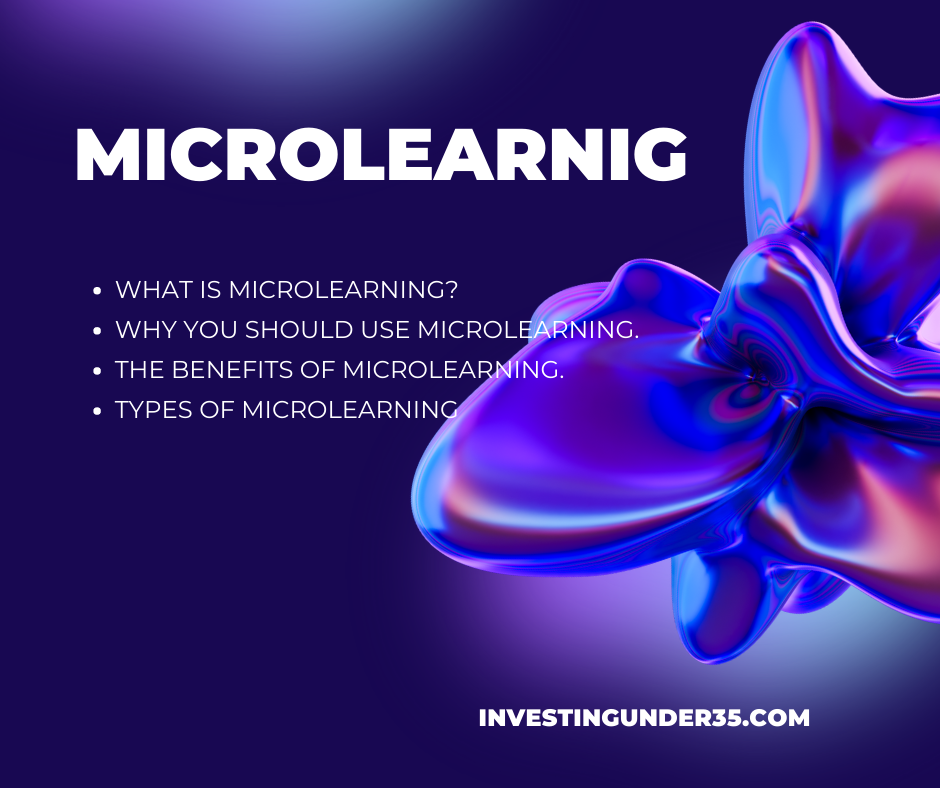Microlearning is a way of learning that takes advantage of our brains’ ability to learn and retain information in short bursts. Microlearning is an effective tool for any situation where you can’t stop what you’re doing and sit down for hours at a time—such as on your lunch break or while waiting for an appointment. Microlearning can also help prevent information overload because it keeps the focus on what’s most important.

What is microlearning?
Microlearning is a form of accelerated learning that uses short, focused learning courses to deliver knowledge in small, easily digestible chunks. This can be done through video tutorials or text, and the goal is to help you learn new skills in less time than it would take with traditional methods (e.g., reading an entire book). For example, you can use microlearning to learn about investing on reddit.
Microlearning is ideal for those who have busy schedules but still want to stay up-to-date on their industry and improve their skillset. It’s also great for people who need to refresh on old information after a long break from work (like taking maternity leave), or if they’re switching careers entirely and need a crash course in something completely different.
Why you should use microlearning.
Microlearning is a great way to increase learner engagement, learner retention, learner motivation and learner satisfaction.
🎓 Learners crave short bursts of learning because they’re too busy to sit through long lectures or watch long videos.
👏 Microlearning is easily digestible. You don’t have to invest hours at a time in one session. Instead, you can learn in smaller chunks throughout your day or week—making microlearning more convenient for busy lives than traditional learning formats.
⏰ With so much information out there competing for our attention (and our time), we need a tool that helps us retain what we’ve learned and put it into practice quickly—which is exactly what microlearning does!
The benefits of microlearning.

Microlearning Benefits
Microlearning is great for a number of reasons, but most importantly it can help you:
🚀 Get learners engaged. In the same way that you are more likely to watch a show on Netflix if it’s only an hour-long, microlearning allows you to deliver bite-sized lessons that are easy to digest.
🔍 Learn new skills in small increments. If your company needs employees with a specific skill set or level of expertise, microlearning is an excellent way to get them there quickly and efficiently.
✉️ Learn about specific topics and issues relevant to your workplace (e.g., diversity training). Microlearning allows for targeted learning experiences that are easy for employees to digest without feeling overwhelmed or bored with content they don’t care about as much as their day-to-day work responsibilities
Types of microlearning and when to use them.
There are several types of microlearning.
Learning that’s delivered in a bite-sized format. For example, a short video clip, an audio recording or an infographic.
Learning that’s delivered in shorter sessions than traditional learning methods (like classroom training). For example, 20 minutes or less per session.
Short lessons on specific topics and skills rather than full courses with prerequisites, outcomes and a curriculum roadmap. For example: “How to create an excel spreadsheet,” versus “How to create a spreadsheet for marketing purposes.”
A typical microlearning course.
A typical microlearning course is made up of three or four modules, each lasting between 15 and 30 minutes.
Lessons are released once per week and are designed to fit into a busy schedule—they’re easy enough to learn in under 20 minutes. Each lesson has one or two main concepts, with some supporting material that you can refer back to later as needed.
Microlearning examples.
An example of how microlearning is used is when a company trains employees on how to use its software. Instead of sending them to a two-day or weeklong class, the company can send each employee a short video that teaches them everything they need to know about using their new software program in 20 minutes or less. This can save companies money and time by eliminating travel costs, hotel stays, and other expenses associated with long-term training. It also helps ensure that employees learn what they need to know because they aren’t overwhelmed by information overload since videos are short in nature (about 10 minutes long).
Microlearning platforms: There are several platforms on which you can create your own microlearning content for free or for an affordable price such as Udemy, Skillshare, Coursera and others; however there’s been limited research into their effectiveness compared with traditional training methods like face-to-face instruction or eLearning courses created using tools such as Adobe Captivate.
Tips for effective microlearning.
Here are two important tips for effective microlearning:
Use short videos. In general, the ideal video length is about three minutes or fewer. If you’re able to keep your videos under five minutes, that’s even better! You can also use a series of shorter videos rather than one long one. For example, if you’re teaching a course on how to cook different types of fish, consider creating separate videos for each type of fish (e.g., salmon and trout) instead of a single video with multiple segments. The same goes for ebooks—if you’re trying to sell an ebook about cooking salmon in different ways, consider breaking it into multiple ebooks based on what type of cooking method you want people using (e.g., grilling versus poaching).
Use short quizzes and checklists. The best way to measure learning is by assessing someone’s current level compared to their goals: where they are now and where they want/need to be in order to achieve some kind of outcome (e-commerce sales conversion rate increase). An excellent way to implement these assessment questions is through quizzes at the end of each module or chapter within an online course platform like Udemy or Coursera; they can also be done as printed worksheets that are given out before class starts, so students know what materials they need before coming into class having already completed prior work beforehand.
Microlearning helps learners stay focused and learn more in less time
Microlearning helps learners stay focused and learn more in less time. The short, bite-sized videos keep learners engaged because they’re the perfect length for learning on the go. They don’t feel like a chore, but rather something you can pick up here and there throughout your day.
It allows you to learn at your own pace—you can view all of the content without feeling overwhelmed or pressured to keep up with anyone else’s schedule. It helps you learn in a way that is more relevant to your needs than traditional methods of learning (like one long presentation). If you are interested in learning more about finance, we have plenty of investing resources availabe.
As you can see, microlearning is a powerful tool that can help learners learn more and retain information better. With the right tools and techniques, anyone can create practical microlearning courses.

